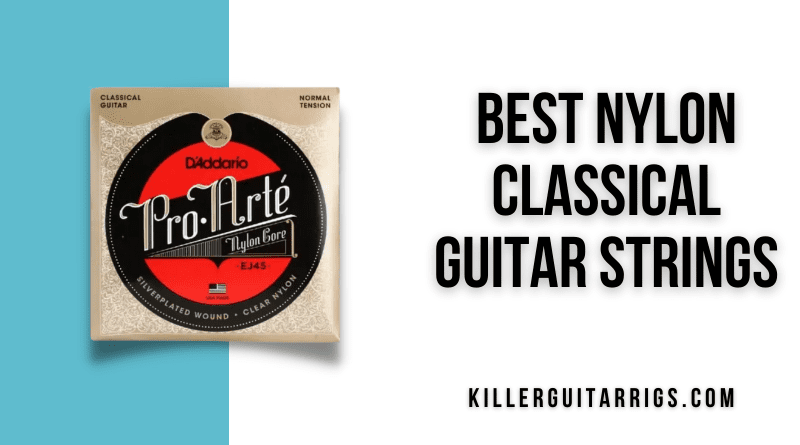One of the keys to a great-sounding classical guitar is to have it fit with the best nylon guitar strings for your style.
It is often said that new guitarists should start their playing journey with nylon strings, which are typically more comfortable than steel strings. The spacing is also wider, making it a little easier to finger notes – but what many don’t realize is there’s a lot more to nylon than a comfortable entry point for new players.
Some of the world’s best musicians play classical guitar exclusively. As with any steel string, there are a number of factors that separate the finest classical strings from those not worth bothering with. In this KillerGuitarRigs Guide, we’ve done the legwork for you, reviewing a wide range of nylon and classical strings to come up with a list of the seven best on the market.
To ensure an even test, each set was loaded into our Cordoba C7 spruce-top guitar, and we focused our test on tuning stability, tone, and playability.
In addition to our list of the best classical strings, we’ve also put together a buyer’s guide to help you choose. You’ll learn:
- What’s the Difference Between Nylon and Carbon Strings?
- How Long Do Classical Strings Last?
- And Much More!
Read more about our review process.
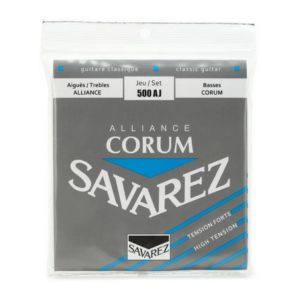
Savarez S.A. 500AJ Alliance Corum
Features: Silver plated wound strings, High tension, Carbon trebles
Benefits: Consistent playing feel, Crisp tones, Reliable performance
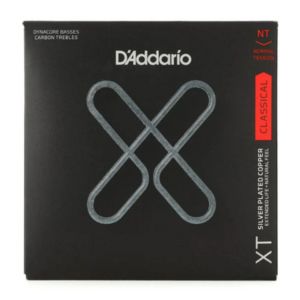
D'Addario XTC45FF XT Dynacore
Features: Corrosion resistance treatment, Carbon monofilament trebles, US Made
Benefits: Extreme lifespan, Dynamic responsiveness, Incredibly clear projection

D'Addario EJ27N
Features: Silver plated copper wound strings, Normal tension, Clear nylon trebles
Benefits: Excellent sustain, Warm tones, Long lifespan
Contents
Our Top 3
We found that the D’Addario XT Classical Dynacore Carbon was a phenomenal All-Rounder string set. They did well across a wide range of music, settled into tune quickly, and gave us no issues throughout the test. A great choice for players of all skill levels.
Our Best Budget set was the D’Addario EJ27N Classic Nylon. D’Addario’s famous attention to detail has clearly gone into these strings. They are well-made, sound good, and feel excellent. Whether you’re a student or professional, these strings will serve you well.
If you’re looking for some of the finest classical strings available for purchase today, consider our Editor’s Choice winner, the Savarez S.A. 500AJ Alliance Corum. They offer a full, rich sound experience and superb tuning stability. Both beginners and experienced players alike will love the dynamism that these strings offer.
Individual Reviews
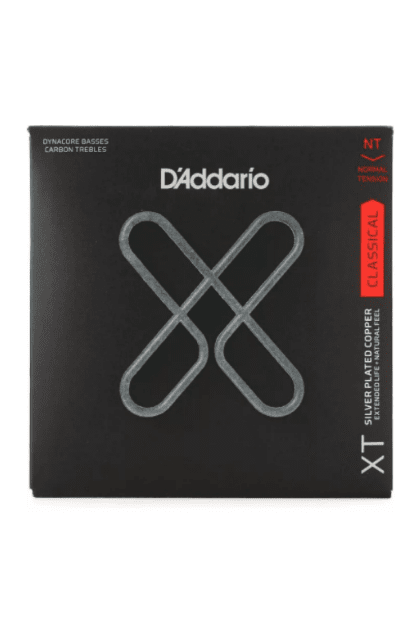
D'Addario XT Classical Dynacore Carbon
Long lifespan classical strings with superb projection and great stability.
These strings offer classical tones with a high tech modern twist. The use of carbon in the treble strings makes them really easy to live with, and assists greatly with both string life and tuning stability.
The XT Classical Dynacores are some of the latest offerings from D’Addario. The set is made up of Dynacore silver-plated copper composite bass strings and Pro-Arte carbon-treble strings. They are designed for extreme longevity and great tone throughout their lifespan.
We were truly impressed with their bright sound and solid feel, and we were particularly impressed with the improvement in intonation over standard strings. The manufacturing process that D’Addario uses on this particular line ensures that every string is consistent, and we found that this really helped to ensure the pitch was correct across the fretboard.
Tuning stability was superb with these strings. Being carbon, the treble strings don’t have the same amount of elasticity as a typical nylon, so not only did they hold tune, they required virtually no stretch before holding pitch properly.
Projection was outstanding with these strings installed. Not only was the overall volume excellent, but the vibrance and balance they brought made them a pleasure to play. They suit soloists particularly well, especially those playing with ensembles. Tonally, they were most present in the mids and lows, and this kept the sound rich without becoming muddy. Sustain was another strong point for these strings, which is again down to the use of carbon in the trebles.
Verdict: Classical strings have long been seen as antiquated, but these D’Addario XT Classical Dynacore Carbon strings show that technology does have its place in the world of classical guitar. They last forever, sound great, hold their tune brilliantly, and suit a wide range of music very well.
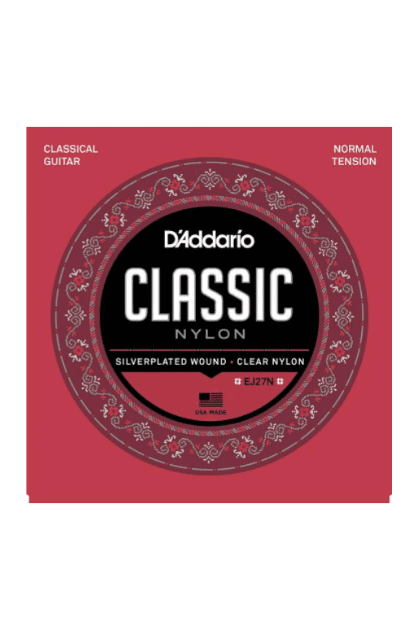
D'Addario EJ27N Classic Nylon
Top strings for student players and guitarists on a budget.
Cheap doesn't have to mean low quality, and these simple D'Addario nylon strings prove that. They are comfortable, they project well, and they offer superb balance.
Our Best Budget winners, the D’Addario Classic Nylon (EJ27N), represent incredible value blended with solid performance for players novice to advanced. As with all D’Addario strings, you’re assured quality, reliability, and consistency in every pack.
When it came to tone, we found these strings were nicely balanced. They had a strong presence in the mids and we were very pleased with the clarity considering the extremely low price. The bass strings are silver-plated copper wrapped around a nylon core, with clear nylon on the treble side.
As for tuning stability, they took a little over 4 days to finish stretching, but held pitch nicely afterwards. As far as comfort was concerned, they were amongst the best we looked at for this review. We tested them in a medium tension, which felt great under the fingers while still allowing for a lot of expressive playing.
The projection was good, and the volume was well-balanced across all six strings, which was particularly impressive as the bass side tends to overpower the trebles on the majority of lower-end classical string sets. They offered excellent forgiveness, especially for technique-based errors, which students and novices will absolutely love about these strings.
Verdict: The D’Addario EJ27N Classic nylon strings aren’t the flashiest, or the most high-tech strings on the market, but they really do sound excellent. They are smooth and rounded, perfect for legato, and you cannot argue with the price. Whether you’re just learning or you’d like to restring your classical guitar at minimal cost, these are a great choice.
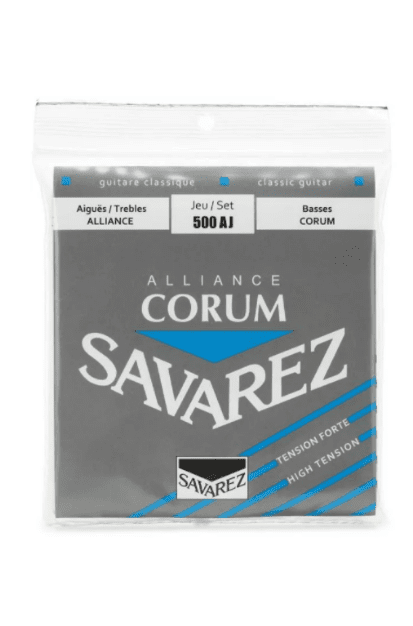
Savarez S.A 500AJ Alliance Corum High Tension
Some of the finest classical strings on the market today.
If you're looking for incredible brightness, and exceptional tones, look no further. These Savarez strings are beautifully balanced, and the quality is incomparable.
Our Editor’s Choice award winner, the Savarez Alliance Corum (500AJ) impressed us on every front. These are premium strings designed for discerning musicians.
Let’s start with the most important thing – the tone. These strings are some of the brightest classical strings you’ll hear anywhere. We absolutely loved the tonal balance, they were rich and bassy, with clear mids and shimmering trebles. Projection was absolutely outstanding, as was volume control. With these strings, you’ll have no problems whatsoever cutting through an ensemble.
The bass strings are silverplate wound Corums with carbon-treble strings. They were strong and firm, but retained enough pliability to stay comfortable. After installation, they stretched quickly and settled into tune beautifully.
These strings were super dynamic, warm and mellow when we needed them to be, while still able to be focused with a sharp attack on demand.
The quality of the construction and the feel was outstanding. They were perfectly intonated from the get-go, which is a huge plus. By the end of the review process, they remained just as bright and articulate as the day we installed them, a testament to the quality of the materials and the QA process during manufacturing.
Verdict: These Savarez S.A. 500AJ Alliance Corum strings are certainly not the cheapest on the market, but they are truly worth the additional expense for players looking to extract the most out of their guitars. Classical guitar is such a nuanced style that the most minute difference in your technique can make a huge difference to your sound. With these strings, you’ll be able to explore every tonal possibility.
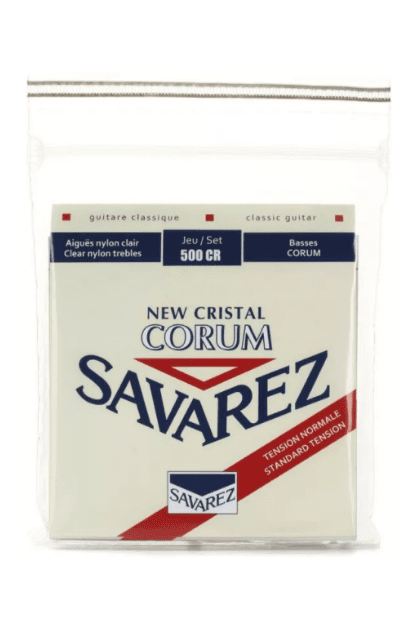
Savarez S.A 500CR New Cristal Corum Normal Tension
Well made strings with great personality and clarity.
You'll get great volume and wonderful feel from these Savarez strings. The silverplate winding on the bass side keeps the tones bright, and the clear nylon trebles are some of the liveliest around.
Savarez is another longstanding name in the strings business. They have been producing some of the world’s best since 1770, and this experience still serves them well today.
We found that the New Cristal Corum set was one of the smoothest on test, which made any legato-playing sound fantastic. The overall feel was excellent – bass strings were tactile and the trebles avoided the plastic feel that can plague clear nylons.
Volume and projection were good, although we found that the bass strings overpowered the trebles for close to a week after installation. The bass side is silverplate wound, which results in the crisp tones you’d expect from this type of string, and the Cristal trebles are bright and lively.
It took close to 48 hours for these strings to settle and retain tuning stability, which could certainly be improved upon, but is far from the worst we’ve ever experienced.
Verdict: These Savarez S.A 500CR New Cristal Corum strings suit cedar/mahogany guitars particularly well. They are bright and punchy and about as smooth-sounding a string as you’ll find anywhere on the market. With that being said, if you tend to play more staccato, these may not be the strings for you. If you’ve got the patience to wait a day or two for strings to stretch and a few more days of play for the bass side to mellow, you’ll be rewarded with a great set.
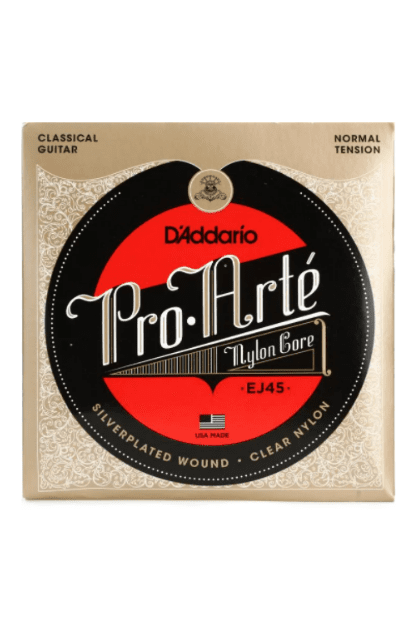
D'Addario EJ45 Pro-Arte
Smooth, mellow strings offering lots of forgiveness and warmth.
For players looking for extreme consistency between packs, these strings offer some of the best. D'Addario use laser sorting technology to ensure extreme ccuracy, and identical tones every time you restring.
It’s no secret that D’Addario makes some of the best strings in the industry, and their continued commitment to innovation has ensured that they lead the way when it comes to string technology across all genres. Their Pro-Arte stings are sorted post-manufacture, using a laser-based system to ensure complete consistency.
This set uses a clear nylon treble side and Pro-Arte silver-plated copper bass strings around a multi-filament nylon core. This combination can give them some lovely warmth and rich bass when paired with the right guitar. If you’re using an HPL (high-pressure laminate)-bodied guitar, you might find the nylon in particular can sound a little muddy. With a solid wood top, back, and sides, however, you’ll get the full depth that these strings can offer.
Another thing that these strings are lacking is great projection. They aren’t bad, but can be a little quiet, especially when compared to carbon strings. So if you’re looking for something with more bite, these may not be the best strings for you.
One thing these strings do particularly well, though, is legato. They’re smooth and well-rounded, and the mellow tone provides a lot of forgiveness, which makes them ideal for novices and music students.
Tuning stability wasn’t bad. They needed quite a bit of stretching before they’d hold pitch properly, but once we had them settled, they stayed right where they needed to be.
Verdict: These D’Addario EJ45 Pro-Arte strings offer great value and solid playability for novices, but more experienced players may want to look at a more high-performance string set. Regardless, these are rich and warm strings, made to the highest standards, which ensures that every pack you buy will feel identical.
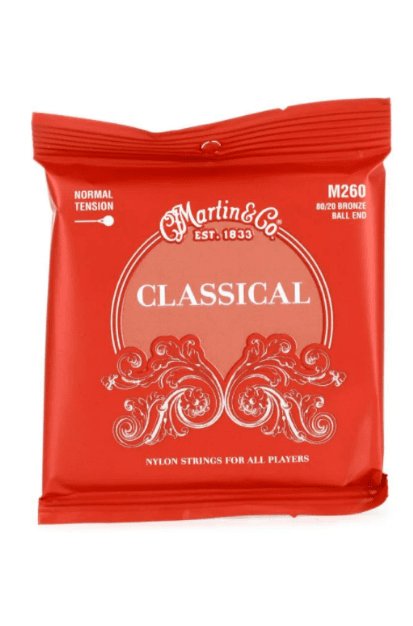
Martin M260 Classical
Familiar Martin quality with the convenience of a ball end.
These are high end strings for discerning players. In addition to their superb tones, and bright character, they also offer a convenient ball end for quick string changes and improved tuning stability.
Martin is most famous for their steel-string acoustics, but they also make some beautiful classical guitars. Just like their steel-string counterparts, Martin nylon-strung instruments stand for quality construction and quality components – including strings like these M260 ball end strings. If you’re transitioning from a steel-strung instrument, or you’d just prefer to avoid having to tie off your strings, these are a great choice.
We’ll start with the most prominent feature of these strings, the ball end. Not only did they make restringing our test guitar much faster, but we found that it drastically improved the tuning stability and settling time.
Considering these are effectively budget strings, they stretched in and held tune more like a premium string, taking less than a day to hold pitch properly. This is likely due to the ball end, as a tied-off string will pull through and slip as the strings are stretched and subsequently tightened.
Unlike the other strings in the test, these Martins were wrapped in 80/20 bronze. This results in a much more familiar tone for those who are transitioning from a steel string, and would be a good choice if you were starting off on a nylon-strung guitar with the intent of moving to steel later on.
We found they were initially very loud, projecting very well, and the balance was good. The main issue we noted was how quickly the brightness and balance disappeared as the bronze tarnished.
Verdict: These Martin M260 Classical strings are a great choice if convenience is important to you. They’re quick to change, hold tuning well, settle quickly, and they’re inexpensive. The tradeoff being that they aren’t as long-lasting as a silver-plated equivalent.
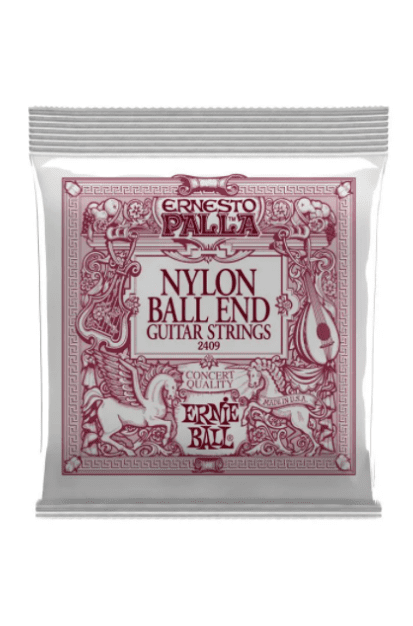
Ernie Ball "Ernesto Palla" Nylon
Reliable strings from a name you can trust.
With these strings you're getting affordability, and great quality. They're well balanced tonally, offer great tuning stability, as well as plentiful volume and projection.
Ernie Ball is, together with D’Addario, one of the leading guitar-string manufacturers in the world. While they’re mostly recognized for their Slinky-series steel strings, they do also happen to make great strings for classical players.
These Ernie Ball Nylon Ball End strings are great for style-conscious players. They’re made with unique-looking black nylon treble strings made from monofilament for a great feel and smooth tone, while the bass-side strings have a multifilament core with a silver-plated copper wrap.
Tonally, they lacked some balance. The bass side is very bright while the trebles are significantly warmer, with little gradation between the two sides. We did find that the strings held their tone well throughout the test. They did have good presence in the bass register, but the mids were a little thin.
Volume and projection were good. We didn’t have to work too hard in order to raise the volume and we were able to keep the guitar quiet when playing more delicate music.
As far as tuning stability was concerned, the majority of the stretch was completed quickly. Within about 6 hours, the strings were holding tune, although frequent, small touch-ups were required thereafter. As with the Martin strings, these came with ball ends, which made swapping strings a really straightforward task, and no doubt was a big factor in the stretching speed.
Verdict: A strong all-rounder type string, and from a well-recognized name, too. The Ernie Ball Nylon Ball End string suits a wide range of styles, and there’s definitely a cool factor with the black trebles. These strings are a great option if you want the convenience of a ball end, but you’d prefer to have a more classical silver-plated tone, rather than the very steel-string sound you’d get from an 80/20 bronze like the Martins.
How to Choose the Right Strings for You
In the below guide, we’ll answer some of the most commonly asked questions about classical guitar strings to help you in your purchasing decision.
What’s the Difference Between Nylon and Carbon Strings?
Nylon strings have been the standard for classical guitars ever since players stopped using animal byproducts in the 1940s. As plastics became more commonplace, it was possible to make much more consistent strings using nylon, and gut strings disappeared for all but a few stalwarts.
Nylons serve their purpose well, as they’re inexpensive and simple to manufacture while still sounding great. As with most areas of music technology, however, as new materials become available, they bring with them advancements in what is possible in feel, tone, lifespan, and more.
One of the more recent innovations in classical string technology has been the invention of carbon strings. While they’re called carbon, it isn’t the same type of carbon fiber that you’ll find on high-performance cars or sporting equipment. In fact, they are still made from nylon, but a different type of nylon known as fluorocarbon (polyvinylidene fluoride). Those of you who fish may already be familiar with this term, as it’s commonly used as a fishing line.
Interestingly enough, carbon strings are prized for their tonal resemblance to gut strings, which makes them popular amongst players looking to recreate the vintage sound without having to source animal-product strings and without the ethical issues that can put some off the use of those strings.
So, what’s the difference? Below, we break down some of the pros and cons of nylon and carbon strings to make the differences easy to digest.
Nylon
Pros
- Inexpensive
- Widely-available
- Tonally very colorful
- Great for legato and vibrato
Cons
- Can sound plinky or plasticky
- Volume balance between treble and bass strings can be very noticeable
Carbon Strings
Pros
- Incredible volume and projection
- Extremely long life
- Extreme sustain
Cons
- Less comfortable than nylon
- Can be too bright for some tastes
How Long Do Classical Strings Last?
As with steel strings, classical strings also have a limited useful life. This can vary wildly depending on the conditions in which you use the guitar, as well as the type of string and how often you use the instrument.
The wound bass-side strings are typically the first to degrade noticeably. As the oils from your skin interact with the metal, the winding begins to tarnish and eventually corrode, all the while losing tone, volume, and strength.
After a while, the nylon treble strings will also begin to degrade. While they won’t rust or corrode, they will start chipping and peeling and can also be easily worn down due to friction on the frets.
The average hobbyist guitarist will be able to get around 90 hours of playtime out of a set of standard nylon or carbon strings before the sound becomes too dull to be of any use. Of course, if you’re playing your guitar outdoors, you can probably reduce this time by 25-50%, as the UV rays of the sun will impact the nylon, and the humidity will attack the wound strings.
Professional players, particularly those playing concerts, will want to consider changing their strings at least every second week. Classical guitars have no way to mask bad tone with FX or even the natural distortion of a cranked tube amp, so as soon as the strings begin to lose their freshness, it’s time for the pros to change to a new set.
Of course, this can be an expensive proposition, especially for those who play performances to audiences. As an amateur, it’s important to balance the performance against the cost of the strings you’re considering for your guitar.
Final Thoughts
Classical strings are a lot more sophisticated than many give them credit for. The slightest difference in manufacturing standards can mean the difference between an orchestra-quality string or something below student grade.
The strings we reviewed in this guide all come highly recommended, but we’d like to close by recapping our favorites.
The D’Addario XT Classical Dynacore Carbon set is a wonderful choice for classical guitar strings if you’re looking for a good combination of tone, volume, and playability.
The D’Addario EJ27N Classic Nylon string set was our Best Budget pick, as they’re wallet-friendly and more than suitable for players of most levels.
Finally, our favorite of all classical guitar strings are the Savarez S.A. 500AJ Alliance Corum. These are, without a doubt, some of the very best classical strings on the market, they were tonally complex, comfortable to play, and effortless to tune.

